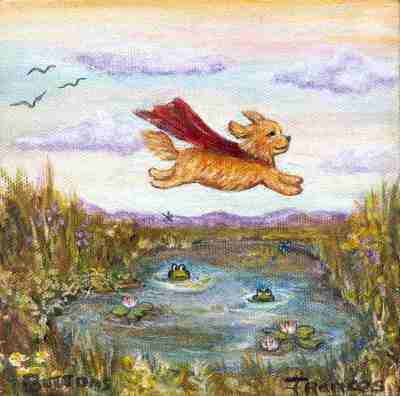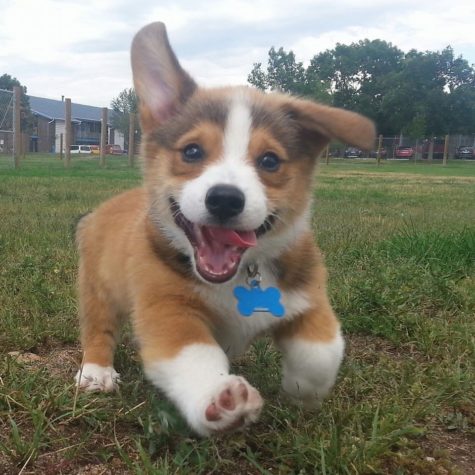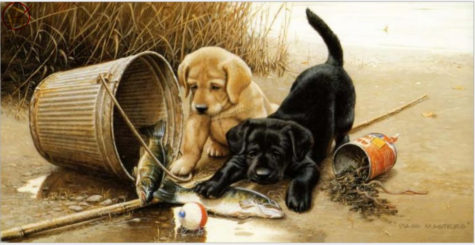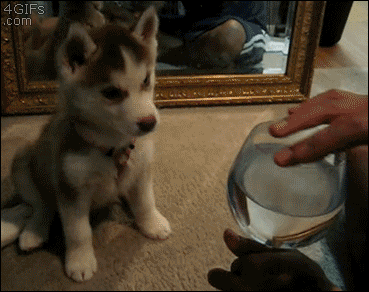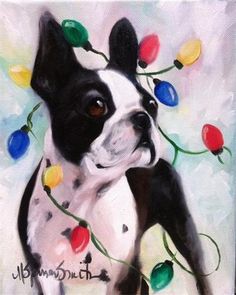Praise
Teaching the Release Command
What it means:
Free puppy. It is now OK to do whatever you want (within reasonable limits).
- Verbal Command: “Perfect!”
- Tone of voice: Happy, excited
- Hand Signal: None
Body Language:
Move forward with your puppy in a happy, thankful, “I’m proud of you!” way.
Enforcing the command:
Clap your hands, pet your puppy, bring your puppy out of position in a positive rewarding manner.
Alternative Command Words:
You can choose whatever word you’d like to use for the release. I like the word “Perfect” because it inspires me to expect perfection from my puppy, and it’s not a word that I use a lot in daily conversation. If you prefer, you can use, “Thank You!” or “Wowsers!” or “Super” or any other word or phrase. Some training methods use “Okay” as a release command. The most important thing is to be consistent with your use of this word.
Do’s and Don’ts:
Be consistent with this command. This is very important, and I cannot stress it enough: Do not allow your puppy to break from any command without this release. This command is a form of praise, and the happy tone of voice is very important, as is the movement forward, and plenty of praise afterwards.
What your puppy learns:
How to please you; how to wait; and that self control is not a ‘forever’ command, and therefore not impossible.
Written by: Shirley Gibson
Note:
You are welcome to share this post but ONLY IF you give credit and a link back to Teach Your Dog To Behave or shirleytwofeathers.com.
Temperaments and Training
Your dog’s basic temperament is genetically encoded into his/her DNA. What follows is simple explanation of what type of training works best with each of the basic temperaments. For an explanation of temperament vs personality, and what to look for, see: Temperament vs Personality
SUBMISSIVE / fearful / combative
Can be a “fear biter,” must be handled carefully and calmly. Corrections must be firm but nonthreatening and impersonal. Lavish praise and gentle handling are very important. Can be very difficult to train.
SUBMISSIVE / sensitive / timid
Requires special handling, needs patience and understanding, but should not be coddled or spoiled. Too much coddling may turn this dog into a neurotic mess. Be firm, but use mild corrections. Lavish praise and a happy positive attitude goes a long way.
RESPONSIVE / sensitive / moderately submissive
Willing to please, eager to learn, quick to understand, responds well to mild corrections and generous praise. Care must be taken not to overly intimidate this type of dog. Can be quite bossy and naughty if spoiled.
RESPONSIVE / moderately aggressive
Willing to please, eager to learn, quick to understand, responds well to confident handling, firm corrections and generous praise. Easily spoiled. Can become a bratty “problem child” if not given rules and taught respect.
DOMINANT / strong minded / determined
Stubborn, does not like to submit to authority. Is sometimes willing to please, but not necessarily on your terms. Requires patient, persistent and firm handling, will take every opportunity to resist. Corrections should be vigorous and full of confidence. You must be assertive and demanding if you want this dog to respect and obey you. Generous praise is important, but it must be earned.
DOMINANT / aggressive
Resists learning, not eager to please. Requires special handling. You must be firm and strong minded with this dog. Avoid direct confrontations as a dog with this temperament will not be able to resist fighting back. Can be dangerous and difficult to train when fully matures.
Variations of the Basic Types
CALM / slow/ easy going
Willing to please, but not eager. Willing to learn, but not quick to respond. Praise, patience, and tolerance are needed. Go overboard with praise. Do not use harsh corrections with this dog.
EXCITABLE / high energy
This high energy type dog is easily distracted and excited about pretty much anything and everything. Requires firm but calm and patient handling, vigorous corrections, and quiet praise. Is often eager to learn and quick to understand, but may not be so willing to please.
INDEPENDENT / aloof
Self reliant and often mistrusting. Not a “people” dog. A good rapport is essential, corrections must be firm, but never harsh. Praise is very important. These dogs respond well to long walks, and a good run is an effective reward or form of praise. The more time you spend with this dog, the easier it will be to build the necessary rapport.
Written by: Shirley Janner
Note:
You are welcome to share this post but ONLY IF you give credit and a link back to Teach Your Dog To Behave or shirleytwofeathers.com.
Puppy Training – Reinforcements
What follows is an in depth explanation of the different forms of reinforcement, along with general guidelines about when and how to use them.
What is Reinforcement?
Reinforcement is information. It tells your puppy just what you like and don’t like. It works only on behavior that is already occurring. You cannot reinforce behavior that isn’t happening. Timing is critical. It must happen at the exact same time as the behavior you want to modify.
Positive Reinforcement
- Encourages specific behavior to be repeated.
- Something your puppy wants.
- Praise (“good puppy”). Tone of voice is very important.
- Petting, tummy rubs, etc.
- Attention, eye contact.
- Feels good.
- Use generously.
- Timing is critical – I cannot stress this enough.
- Positive reinforcement that occurs too soon teaches your puppy how to manipulate you.
- Positive reinforcement that occurs too late reinforces the wrong behavior.
- Positive reinforcements that involve food should be limited to one small mouthful. Use sparingly on specific behaviors only.
- Come when called.
- “Out.” Get your nose out of my food.
- Successful potty break outside.
- To revive interest in previously learned behaviors.
Negative Reinforcement
- Discourages specific behavior.
- Something your puppy wants to avoid.
- Verbal correction (“NO”), tone of voice important.
- Physical correction.
- Hard squeeze of muzzle or feet for jumping or biting.
- Sharp jerk with a leash, or hand on collar.
- Scruff shake.
- Quick spin through the air.
- Squirt bottle.
- Shake can or other sharp noise.
- Feels bad.
- Use sparingly.
- Timing is critical – I cannot stress this enough.
- Negative reinforcement that occurs too late is called “punishment” and does nothing to educate your puppy.
- Negative reinforcement that occurs too soon may actually prevent the behavior you are trying to encourage.
- Negative reinforcements should be only just strong enough to make an effective impression, but not so strong as to cause fear.
Jackpots
- A surprising reward 10 times bigger than what your puppy is used to (treats are acceptable).
- Can be used to mark a sudden breakthrough.
- And also as a morale booster.
- Will help your puppy maintain a positive attitude about you, and the training.
- Do not do this very often or it will use it’s effectiveness.
Conditioned Reinforcement
- Teaches your puppy to respond to the following:
- Verbal praise – an all purpose positive reinforcement.
- Verbal correction – an all purpose negative reinforcement.
- Other signals – reinforcement for specific behaviors.
- Sounds such as bells, clickers, whistles.
- Motions such as hand signals, or specific actions.
- Lights, or anything your puppy responds to visually.
- Establishes more exact communication.
- Tells your puppy exactly which part of a behavior you like the best.
- Reinforces behavior without interrupting it.
- Has more power than ordinary reinforcements because:
- It works on an unconscious level.
- Can be paired with several ordinary reinforcements such as:
- Food, water, and petting.
- Tummy rug, treats, focused attention.
- Loud noise, squirt bottle, leash correction.
- It says, “You’re right!” which is important information, and a valuable reinforcement by itself.
How to establish a conditioned reinforcement
- Verbal Praise
- Pick one phrase and use ONLY for this purpose.
- “Good Puppy” or “Very Good” or “Thank You”
- Something similar to the above.
- Always use a POSITIVE tone of voice.
- Say the phrase when giving food, water, treats, tummy rubs, ear scratches, etc.
- Do NOT continue to say the phrase after the positive reinforcement is finished.
- Pick one phrase and use ONLY for this purpose.
- Verbal Correction
- Pick one phrase and use ONLY for this purpose.
- “Bad” or “No” or “Shame on you.”
- Something similar to the above.
- Do not use in conjunction with your puppy’s name.
- Always use a STERN demanding tone of voice.
- Say the phrase when using negative reinforcements.
- Do NOT continue to say the phrase after the incident, or naughty behavior is finished and dealt with.
- Pick one phrase and use ONLY for this purpose.
- Signals, bells, clickers, whistles, lights, etc. for POSITIVE reinforcement.
- Make the signal and give a reward.
- Do this until the signal brings the puppy to you for another reward.
- When the connection between the signal and the reward is made, begin to use the signal to reinforce behavior while it is happening.
- Use the signal for ONE behavior at a time.
- Use your conditioned reinforcements sparingly.
- Try to pick words, phrases, and or sounds that your puppy will not ordinarily hear during the course of the day.
- Do not repeat the words or sound over and over again during the action unless you have a specific reason.
How to maintain what your puppy has learned.
- Random Reinforcement.
- Positive reinforcement should be constant and consistent during the LEARNING process only.
- As soon as your puppy has learned a specific behavior, cooperation is expected.
- Positive reinforcement is given only when the behavior is done quickly, or unusually well.
- Do not use random reinforcement to eliminate unwanted behavior.
- Avoid pampering and spoiling.
- If positive reinforcement is too easy for your puppy to achieve, the desire to try harder will NOT be reinforced, and you will get less and less instead of more and more.
- If negative reinforcements are easy to ignore, your puppy will continue to test established boundaries, and you will find yourself in a continual struggle for authority.
- Variable Schedule.
- Do NOT use when working to ELIMINATE behavior.
- Use when the behavior has been perfected.
- Gradually phase out positive reinforcements.
- Limit yourself to reinforcement, every 3rd, 5th, 7th, etc.
- Every now and then throw in a “jackpot.”
- Keep your puppy guessing.
- A long schedule is the most effective.
Exceptions to the variable schedule
- When you are working to eliminate an unwanted behavior.
- When solving a puzzle, or taking a test.
- When it is necessary to make a choice between two or more items, or actions.
- Whenever independent thinking is required, some sort of feedback is necessary, and can be in the form of conditioned reinforcements.
Written by: Shirley Janner
Note:
You are welcome to share this post but ONLY IF you give credit and a link back to Teach Your Dog To Behave or shirleytwofeathers.com.
Puppy Training – Guidelines
Know and understand your puppy.
- Your puppy’s temperament will determine what rewards and which corrections will be most effective.
- Take into consideration how your puppy reacts to his senses.
- Don’t forget that your puppy is a DOG, and that certain behaviors are part of his DNA and to be expected.
- Dogs and puppies are motivated by pleasure, pain, fear, and also by their assessment of their place in the family or pack.
- Dogs and puppies have a strong need for leadership. If you do not take the role of leader, your puppy will.
Teach one thing at a time.
- Too many different things at once can be confusing.
- Divide complicated tasks into simple steps.
Take it one small step at a time.
- Make steady improvement easy for your puppy.
- Do not expect too much too soon.
Don’t rush the training.
- You have to walk before you can run.
- Patience and repetition are important words to remember.
Temporarily ease up on everything else when introducing something new.
- The key word here is TEMPORARY.
- Do correct mistakes, but gently and with patience.
- Expect mistakes whenever something new is introduced, or when working with your puppy in a new place.
Plan ahead.
- Know in advance the desired result.
- If your puppy suddenly catches on to what it is you want, this will give you a good opportunity to make quick progress.
If what you are doing isn’t working…
- If what you are doing isn’t working, and you’ve put in the time, the repetition, and the patience – rethink your strategy.
- Trust your intuition.
- Be open to new ideas.
Timing is very important.
- Everything that happens to a puppy happens right now.
- Praise and correction must be handed out during or immediately following the behavior or yhour puppy will not get the message.
When working with your puppy, stay focused.
- Don’t stop in the middle of a session to talk on the phone, smoke a cigarette, or etc.
- Remember, training is a form of communication.
- Removal of attention can be a negative reinforcement.
Positive and negative reinforcements, how to use them:
- The reward for good behavior must outweigh the pleasure gained from the bad behavior.
- The correction must override but not overwhelm the will of the puppy to continue with the bad behavior.
- Use lots of positive reinforcement.
- Be sparing but effective with the negative reinforcements.
If your puppy suddenly “forgets”…
- If your puppy suddenly “forgets” what he has learned, go back to the basics.
- Sometimes a quick refresher is what is needed.
- A relapse midway into training is common and usually means you are about to make a major breakthrough – so don’t get discouraged and quit.
Quit while you are ahead.
- Make progress in each training session
- End each session on a high note.
- Too much pressure or too many repetitions can ruin a training session. Three times in a row is usually suficient.
- If necessary, end the training session on something easy.
A successful outcome depends on these factors:
- Patience and persistence
- Consistency and repetition.
- Whether or not you took the time to follow through.
Written by: Shirley Janner
Note:
You are welcome to share this post but ONLY IF you give credit and a link back to Teach Your Dog To Behave or shirleytwofeathers.com.
Puppy Training – The Basic Principles
A puppy learns through – Consistency and repetition.
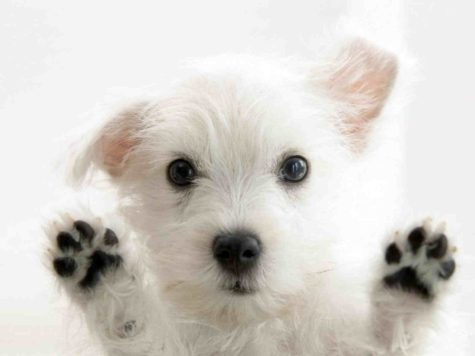 This requires:
This requires:
- Patience
- Persistence
- Confidence
- Follow through
- TIME
You will also need – Knowledge of your puppy’s temperament, an understanding of canine behavior, and a balance of rewards and consequences.
Crimes and Corrections / Praise and Discipline:
- The reward for “good” behavior must outweigh the pleasure gained from the “bad” behavior.
- The correction must override the will of the puppy to continue with the “bad” behavior, without overwhelming the will of the puppy to make decisions.
- The puppy’s confidence in naughtiness must be shaken, and at the same time, the puppy’s confidence in self, and in you, must remain strong.
- An understanding of why your puppy is doing a particular thing can be very helpful, also take into consideration how your puppy reacts to his senses.
- Puppies are motivated by pleasure, pain, fear, and also by their assessment of their place in the family or pack.
- Dogs and puppies have a strong need for leadership. If you cannot take on the role of leader, your puppy will.
Remember:
Everything that happens to a puppy happens right now. Praise and correction must be handed out during or immediately following the behavior or your puppy will not get the message you are trying to get across.
Written by: Shirley Gibson
Note:
You are welcome to share this post but ONLY IF you give credit and a link back to Teach Your Dog To Behave or shirleytwofeathers.com.
